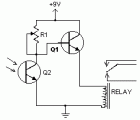FREE
circuits!
Sensor circuit diagrams
January 16, 2011
Here's a circuit that takes advantage of the photo-voltaic voltage of an ordinary LED. The LED voltage is buffered by a junction FET transistor and then applied to the inverting input of an op-amp with... [more]
December 29, 2010
This is an extension of the CMOS toggle flip flop circuit with the addition of two bandpass filters and condenser microphone so the relay can be toggled by whistling at it. The condender mic used... [more]
December 27, 2010
The heater element (not shown) is connected in series with two back to back 16 amp SCRs (not shown) which are controlled with a small pulse transformer. The pulse transformer has 3 identical windings, two... [more]
December 27, 2010
The circuits light a 20 watt lamp when the contacts are touched and the skin resistance is about 2 Megs or less. The circuit on the left uses a power MOSFET which turns on when... [more]
December 12, 2010
A simple device to indicate various levels of hot water in a tank. [more]
December 9, 2010
This circuit controls a load (in this case a dc brushless fan) based on a temperature compared with a setpoint. THe transduced is a diode in the forward polarization regime. In fact when forward biased,... [more]
December 9, 2010
This circuit relies upon the extra high input impedance of a FET, and also demonstrates the gate terminals sensitivity to changes in voltage. The gate terminal here is left open circuit, connected only to the... [more]
December 8, 2010
The piezoelectric element of a kitchen gas lighter is used in this simple, yet effective seismic detector. The piezo element must be placed vertically, one end solidly to ground. [more]
December 2, 2010
This handy little circuit can tell the difference between darkness and light, making it very useful for switching on and off signs, porch lights or other things when it gets dark or light. [more]
December 2, 2010
Egor! Come quick! A storm approaches! Here is a VLF receiver tuned to 300 kHz designed to detect the crackle of approaching lightning. A bright lamp flashes in sychrony with the lightning bolts indicating the... [more]










 This category
This category